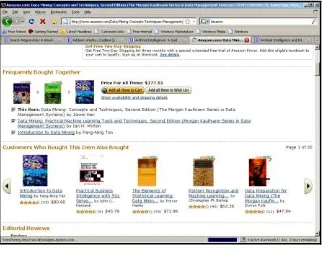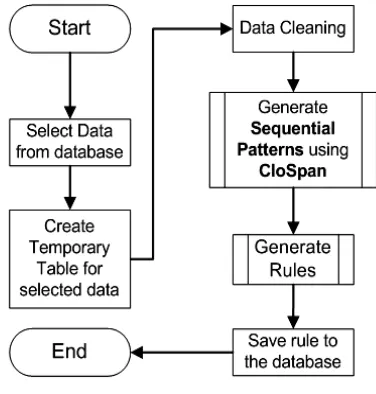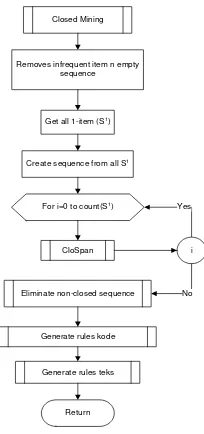CloSpan Sequential Pattern Mining for Books
Recommendation System in Petra Christian
University Library
Gregorius S. Budhi
1, Yulia
2, Hery P. Gunawan
3Information Technology Department Petra Christian University
Siwalankerto 121-131, Surabaya, East Java, Indonesia [email protected], [email protected]
Abstract—Petra Christian University (PCU) Library has been
using website for their books search system. To further improve the service, it is necessary to develop the automatic system which can recommends the book or the correlation or the book which often being lend at the same time or sequentially by prospective borrowers. The algorithm used to explore the lending sequential patterns is CloSpan Sequential Mining algorithm. The output generated by this application is closed sequential pattern rules and the tree of sequential patterns. They can be used as a reference to establish a list of recommended related books. From the test results it can be concluded that the more data and smaller minimum support, the longer the process takes, and the more patterns that is produced. From the questionnaire outcome that are distributed to employees and users of the library can be concluded that the system can create right recommendations and useful.
Keywords—Data Mining, Sequential Pattern Mining,
Clospan, Books Recommendations, Library online bookstores such as Amazon.com (Picture 1).
In order to build this recommendation service feature, researchers approached it with data mining method, namely sequential pattern mining. First it will be mined patterns of frequently borrowed books simultaneously and sequentially. The patterns that were found will be the basis of the recommendations. The algorithm used to dig patterns is CloSpan Sequential Pattern Mining. The output of the system can be viewed in the form of sequential pattern rules and a sequential patterns tree. To further improve the results of mining pattern, we dig data in a multidimensional manner. So that in addition to the book loan data, we entered the books borrower data such as, address, age, home department and the entry year (if a student).
This application is the development and improvement of a similar application that was created earlier using different sequential mining algorithms [2]. The CloSpan algorithm used in this application because theoretically this algorithm produces less number of rules but the same function and also has a faster processing time.
II. BASIC CONCEPT
A. Sequential Pattern Mining
Sequential data is pervasive in our lives. For example, your schedule for a particular day is the sequence of your activity. When you read a story, you informed the development of some of the events that are also sequential. If you have an investment in the company, you are interested to learn the history of the company stocks. Deep in your life, you rely on biological sequences, including DNA and RNA sequences [1].
Given a set of sequences, where each sequence consists of a list of events (or elements) and each event consists of a set of items. Then given limit a user-specified minimum support, mining sequential patterns will found all frequent sub-sequences [4].
B. Closed Sequential Patterns Algorithm (CloSpan)
Broadly speaking, CloSpan consists of two main phases, namely: First phase, bring CloSpan LS set, a superset of the frequent closed sequences, and store it in a prefix sequence lattice, and second phase is post - pruning CloSpan to eliminate non-closed sequences. CloSpan algorithm can be seen in Figure 2 and Figure 3.
Figure 2. Algorithm Closed Mining [5]
Figure 3. CloSpan Algorithm [5]
C. Multidimensional Patterns Mining
This method allows extracting information from multiple attributes or dimensions, so that data mining is not only based on one attribute only. Mining process would be more effective if the main attribute can be associated with other attributes or dimensions, so the result can be seen from many aspects of the associated data [3].
Multidimensional process of pattern mining is as same as single dimensional pattern mining. The different is it was in the beginning it done merging the data with some desired dimensions. After that the dimensions can be considered as separate items, so it can be calculated as a single-dimensional pattern mining. The results obtained are in the form of multidimensional rules.
III. APPLICATION DESIGN
This application is further development of similar application has been made by researcher for PCU library [2]. The developments are as follows:
The addition of multidimensional elements of the
application. With the addition of a sequential pattern will be obtained not only single dimension (book-to-book), but also can be seen from some of the other aspects, e.g.: "If the borrower from the Informatics department will borrow the book Data Mining Concept and Technique next borrowed the book Pattern Discovery Using Sequence Data Mining."
Changes in the algorithms used, namely: from
algorithm PrefixSpan to CloSpan. The reason is CloSpan algorithm produces smaller number of sequential patterns but equally meaningful. These algorithms form a pattern that has only "close" or not to be sub-pattern from another pattern longer. Fewer numbers of patterns will further accelerate the search process when applied to the PCU library books search system.
The Block diagram of design of the application can be seen in Figure 4.
Figure 4. Block Diagram of the Application
Figure 5. Pages to select dimensions, the period of data and specify minimum support.
Next, the application will create a temporary table to store the data that has been selected. The data is then going through a cleaning process where data that is lost or corrupted can be repaired. Cleaning process is divided into two parts, namely:
Cleaning the data manually, which the administrator
can repair or fill corrupted or missing data records.
Cleaning the data automatically. For automated data
cleaning there are some rules to follow, namely:
o Book Title data, when data is empty then it
will be filled with the value 0 (Unknown).
o Data Department, if the field is empty then
the application will automatically track member who borrowed it from his member code. This is because the digits 1 to 3 of the code are the code of members department.
o Student entry year data can be traced also
from the member code digit 4 and 5.
After the cleaning process complete the data is processed using CloSpan algorithm to forming frequent closed sequences. Flowchart of the CloSpan can be seen in Figure 6 and Figure 7.
Closed Mining
Get all 1-item (S1)
Create sequence from all S1
CloSpan For i=0 to count(S1)
Eliminate non-closed sequence Yes
Return Removes infrequent item n empty
sequence
i
No
Generate rules kode
Generate rules teks
Figure 6. Closed Mining Process
CloSpan
Figure 7. CloSpan Process
Then we built rules and tree from the closed frequent sequences. The rules and tree are for the visualization of the results of closed frequent sequences to the administrator or other users in need. Webpage of rules and tree visualization of frequent closed sequence is shown in Figure 8 and Figure 9.
Figure 9. Sequential Pattern Tree
All sequential patterns will be used as the basis for the suggestion that displayed on the web page of the book you looking for in the website of PCU library. There are two kinds of suggestion that are produced, namely:
A list of books frequently borrowed along with the
book that is being viewed, under the header "People who borrowed this book also borrowed ..."
A list of frequently borrowed book after borrowing a
book that is being viewed, under the header " People who borrowed this book then borrowed ..."
The original webpage can be seen in Figure 10. The alterations can be seen on Figure 11.
Figure 10. The original webpage of PCU library books searching system.
Figure 11. Example of the alteration 1 (left) and 2 (right) of PCU library books searching system
IV. TESTING RESULTS
A To test the application, we perform two kinds of tests, namely:
Testing the speed of the CloSpan process to generate
sequential patterns. The result is shown in Figure 12.
Tests on the total rules generated. The result is shown
in Figure 13.
Figure 12. The result of processing time test
Figure 13. The result of total rules generated test
In addition to these two tests, testing was also conducted in the form of questionnaires to some people with an interest in this application, such as the head of PCU library along with his staff, and also some students who often use of this library service. The questionnaires results are shown in Table 1.
TABLE I. THE QUESTIONNAIRES RESULTS
No Job Criteria
A B C D E
1 Head of PCU Library 3 3 4 4 3
2 Collection Sector Supervisor 3 4 4 4 3
3 Junior Programmer 4 4 5 4 4
4 Customer Service Supervisor 4 5 5 5 4
5 Books Processing Staff 5 5 4 4 5
6 Automation Processing Staff 3 3 4 4 2
7 PCU Informatics Dept. Lecturer 4 4 4 4 3
8 PCU Informatics Dept. Lecturer 5 4 4 5 5
9 PCU Informatics Dept. Student 5 4 5 5 4
10 PCU Informatics Dept. Student 4 3 4 4 4
Total 40 39 43 43 37
Mean (Percentage) 80% 78% 86% 86% 74%
Scoring: 1 Very Bad to 5 Very Good
B = Interface design (appearance) of the application.
C = The accuracy of the information produced.
D = Applications can meet the needs of the library.
E = The use of language in the application.
V. CONCLUSION
This application has been designed and implemented correctly. This can be seen in the results of application testing. And also the results of questionnaires from library staffs and prospective users generate good points.
REFERENCES
[1] G. Dong, and J. Pei, Sequence Data Mining, Springer Science + Business Media, 2007
[2] G. S. Budhi, A. Handojo, and S. G. Sutrisno, “Book Loan Recommendation System for Petra Christian University Library using PrefixSpan and Generalized Sequential Pattern Algorithm”, Proc. The 2nd Makassar Int. Conf. on Electrical Engineering and Informatics
(MICEEI’10), pp. 136–143, Makassar, Indonesia, October 2010 [3] J. Han, M. Kamber, and J. Pei, Data mining: Concepts and techniques,
3rd Edition, Elsevier Inc, 2012
[4] R. Agrawal, and R. Srikant, "Mining sequential patterns", Proc. 1995 Int.
Conf. Data Engineering (ICDE’95), pp. 3–14, Taipei, Taiwan, March 1995
[5] X. Yan, J. Han, and R. Afshar, “CloSpan: Mining closed sequential patterns in large datasets”, Proc. 2003 SIAM Int. Conf. Data Mining



